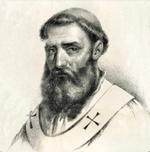Subscribe for free today!
Get newsletters with the latest content, and access to exclusive ebooks and podcast episodes.
Already subscribed? Log in to stop seeing invitations to subscribe.
Catholic Activity: St. Vitus, June 15
Biography of St. Vitus, whose feast day was June 15, but has been suppressed since the reform of the Calendar in 1969. He is one of the Fourteen Holy Helpers. He is also known as St. Guy.
DIRECTIONS
This Saint was martyred, while still a boy, under Emperor Diocletian. Later legends adorn his life with many miracles and events of unusual character. In the eighth century his relics were brought to Saint-Denis, France, and in 836 to the Abbey of Corvey in the East Frankish Kingdom (Germany). Since Corvey was a center of great missionary activity, monks there introduced the veneration of Saint Vitus to the Germanic and Slavic tribes. It soon spread all over France, Germany, England, Scandinavia, and eastern Europe. By the thirteenth century he was widely venerated in all these countries, and many churches were built in his honor (the most famous being Saint Vitus' Cathedral in Prague). His feast was celebrated as a holyday with Mass, pilgrimages, rest from work, and gay festivals.
His peculiar patronage is that of helper in epilepsy, chorea (St. Vitus' dance), and all other diseases connected with nervous shaking and muscular spasms. This is based on the medieval belief that such illnesses were caused by direct influence of the Devil. And since the Saint, according to legend, had freed Diocletian's daughter from the possession of the Evil One, he was now implored to extend the same favor to the Christians, especially to the many children suffering from "Vitus' dance."
The first mention of this is found in the official Annals of the Holy Roman Empire (twelfth century): "Saint Vitus was a little boy; in his torture he prayed to God; whoever has the falling sickness goes to him for help; this our Lord Himself has promised him...."
In the strange "epidemics" of dancing mania that swept western Europe at various times from the fourteenth to the sixteenth centuries, Saint Vitus' patronage grew to gigantic proportions. The victims of that mass hysteria were brought to his shrines and led three times around his altar or statue, to obtain relief or cure. In many places they were even encouraged to dance continuously "in honor of Saint Vitus" until they dropped from sheer exhaustion, which often cured them.
In later centuries this patronage, which originally had been restricted to "dancing" in its morbid forms, was extended to cover the real performance, and thus he also became the patron of dancers and actors.
Saint Vitus is often pictured with a chicken because it was a general custom in medieval times to offer roosters, hens, and eggs at his shrines. This tradition seems to be based on a pre-Christian practice of chicken sacrifices at the time of the summer solstice. It became associated with Saint Vitus because in those early centuries (before the Gregorian reform of the calendar) the solstice occurred in the middle of June.
LITURGICAL PRAYER: Grant to Thy Church, we pray, O Lord, through the intercession of Thy holy Martyrs Vitus, Modestus and Crescentia, not to be proud-minded, but to grow in humility which is so pleasing before Thee; shunning the things that are evil, may she with eager love practice whatever is right.
Activity Source: Holyday Book, The by Francis X. Weiser, S.J., Harcourt, Brace and Company, Inc., New York, 1956






